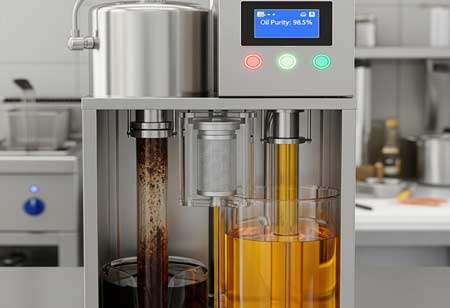THANK YOU FOR SUBSCRIBING
Be first to read the latest tech news, Industry Leader's Insights, and CIO interviews of medium and large enterprises exclusively from Food and Beverage Tech Review
The Culinary Case for Oil Lifecycle Management
Oil purification technology transforms cooking oil into a reusable asset, reducing costs and waste, enhancing food quality, and promoting sustainability in commercial kitchens.

By
Food and Beverages Tech Review | Tuesday, November 25, 2025
Stay ahead of the industry with exclusive feature stories on the top companies, expert insights and the latest news delivered straight to your inbox. Subscribe today.
Oil purification technology is fundamentally reshaping the financial paradigms of commercial kitchens by transforming cooking oil from a disposable commodity into a reusable asset. This paradigm shift enables establishments to mitigate procurement and disposal expenditures, enhance culinary quality, and optimize operational efficiency, ultimately fostering a more sustainable and profitable business model.
The life cycle of cooking oil in commercial kitchens is both short and costly: fresh oil is purchased, heated, and used for frying until inevitable degradation occurs through hydrolysis (reaction with water from food), oxidation (reaction with air), and polymerization (oil molecules linking together under high heat). These processes generate impurities—measured as Total Polar Materials (TPM)—that cause the oil to darken, smoke at lower temperatures, and impart off-flavors, resulting in inconsistent, lower-quality food. The prevailing solution has long been to discard the degraded oil and replace it with fresh oil, a practice that carries significant direct and indirect costs.
The most obvious expense is the constant procurement of new oil, a commodity subject to market price fluctuations. Beyond this, kitchens face costs associated with the safe storage and eventual disposal of used oil, which is often subject to regulation. Add to this the labor hours spent on the messy and time-consuming task of draining, cleaning, and refilling fryers. This traditional "use and discard" approach represents a significant, recurring operational expenditure that managers have long accepted as a necessary cost of doing business.
A Circular Approach to Oil Management
The advent of modern oil purification systems has introduced a paradigm shift, moving kitchens from a linear consumption model to a circular, resource-maximizing one. These sophisticated systems are designed to actively manage the health of cooking oil, intervening before it reaches the point of no return. The core principle is simple yet powerful: instead of waiting for the oil to degrade completely, it is regularly filtered to remove the very impurities that cause its demise.
The process oil undergoes micro-filtration to eliminate large food particles, crumbs, and sediment. This initial stage significantly curtails carbonization, a primary contributor to oil degradation and the genesis of undesirable flavors. After this, the oil may be subjected to treatment with adsorbent materials designed to attract and sequester microscopic, dissolved impurities, specifically the polar compounds that constitute TPM. Through the systematic removal of both visible and invisible contaminants, these systems demonstrably restore the oil's quality, thereby substantially prolonging its operational lifespan. The oil, upon reintroduction to the fryer, exhibits enhanced clarity, cleanliness, and a chemical composition closely mirroring its nascent state, rendering it suitable for continued production of high-quality food.
The Economic Impact of Reshaping the Profit and Loss
The financial implications of adopting a circular oil management model are profound and multifaceted. By significantly extending the lifespan of each batch of oil, kitchens can slash their procurement costs by 50 percent or more. This represents one of the most direct and immediate returns on investment available in kitchen operations. But the economic benefits extend far beyond the initial purchase price. Disposal costs are minimized, as the volume of waste oil is drastically reduced. Labor costs also decrease, as the daily or frequent need for a full fryer change-out is replaced by a quicker, more efficient filtration process. Staff are freed up to focus on more value-added tasks like food preparation and customer service.
Furthermore, there are energy savings to consider. Clean oil transfers heat more efficiently than degraded, viscous oil. This means fryers reach their target temperatures faster and maintain them with less energy, leading to a noticeable reduction in utility bills over time. Collectively, these savings transform a significant operational expense into a far more controlled and predictable cost, improving cash flow and boosting the bottom line.
Operational and Culinary Advantages With a Commitment to Sustainability
While the financial case for oil purification is compelling, its operational and culinary advantages—most notably the enhancement of food quality and consistency—are equally consequential. Cooking with consistently clean oil ensures that every fried item emerges from the fryer with the intended flavor, a golden color, and a crisp texture. It eliminates the problem of flavor transfer, where a batch of fish might impart a lingering taste to the next batch of fries. This consistency is crucial for maintaining a strong brand reputation and ensuring customer satisfaction.
Operationally, the kitchen becomes a more efficient and safer environment. Well-maintained oil and fryers contribute to a cleaner workspace. The systematic process of filtration is inherently safer and more streamlined than a complete manual oil change. By preventing the buildup of hardened, carbonized polymers on heating elements, purification technology extends the lifespan of expensive frying equipment, protecting capital investments and reducing maintenance costs.
Amid growing environmental awareness, oil purification stands out as a robust sustainability measure, reducing consumption and easing the strain on the land, water, and energy needed for oil production, thereby lowering a restaurant’s overall footprint.
The reduction in waste oil diverts thousands of liters from landfills and sewer systems, preventing blockages and environmental damage while delivering significant ecological benefits. Decreasing the frequency of new oil deliveries and waste oil pickups translates to fewer trucks on the road, contributing to a reduction in carbon emissions. This commitment to environmental stewardship is not only responsible but also resonates strongly with a growing segment of consumers who prefer to patronize businesses that demonstrate a commitment to sustainability.
Oil purification technology has transitioned from a specialized solution to a fundamental element within contemporary, efficient, and financially viable commercial kitchens. This innovation redefines the economic implications of a core culinary process by converting cooking oil from a consumable commodity into a continuously managed asset. It concurrently delivers a unique combination of advantages: economic viability, operational superiority, and environmental accountability. For culinary establishments aiming to prosper in a competitive landscape, the adoption of this technology is no longer discretionary but rather the established benchmark for distinction.
I agree We use cookies on this website to enhance your user experience. By clicking any link on this page you are giving your consent for us to set cookies. More info







